Feeling swamped with all the different TRX row exercises out there? Don’t worry, you’re in good company.
Each TRX row has its way of working your muscles, and I’m here to show you 5 key types and how they’re all different. Let’s dive in!
In This Article
How To Correctly Perform a TRX Row
Below I’ll break down the key components you need to know so you can master any row variation with confidence.
Set TRX Straps to Proper Length
Row-specific TRX exercises require you to set your strap length somewhere between its shortest position and a mid-length position.
I typically recommend keeping the TRX straps at their shortest position for most rowing exercises. Depending on your home setup and space, you may need to take a modified approach.
Adjusting the length of your straps is pretty straightforward – I explain how to step by step in this post. For more detailed instructions and official guidelines on setting up your TRX system, check out the TRX official website.
TRX HOME2 System
TRX HOME2 Trainer is my secret for a full-body workouts at home. It's a breeze to set up and works every muscle.
Watch my TRX HOME2 step-by-step video to see why it's my go-to for home workouts.
Foot Position
Set your feet roughly shoulder width to begin.
Slowly walk your feet closer to the anchor point of the straps.
As you do this, your body should be getting lower to the ground, which will get you into the starting position for this exercise.
Bracing & Body Position
Engage your core muscle by sucking your belly button in towards your spine.
Next, take a deep breath inhaling to create internal pressure that wraps around your abdominal muscles and expands both sides of your ribs.
Executing the Movement
Start with your arms fully extended and squeeze your glutes to help keep your body in alignment.
First, focus on squeezing your shoulder blades together and backward
Next, roll your shoulders down towards the ground behind you – this is a subtle movement.
Finally, drive your elbow towards the ground behind you while pulling your chest forward.
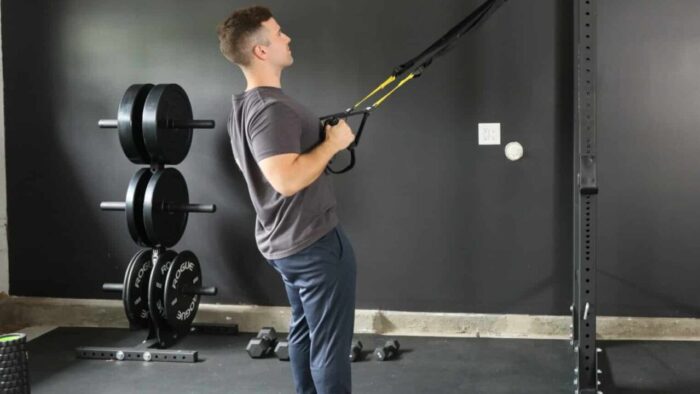
1. TRX Row
The row is one of the core exercises that you should know if you plan to incorporate suspension training into your workout routine.
This version of the row is a bilateral (two-arm) movement that is done standing upright at a slight angle.
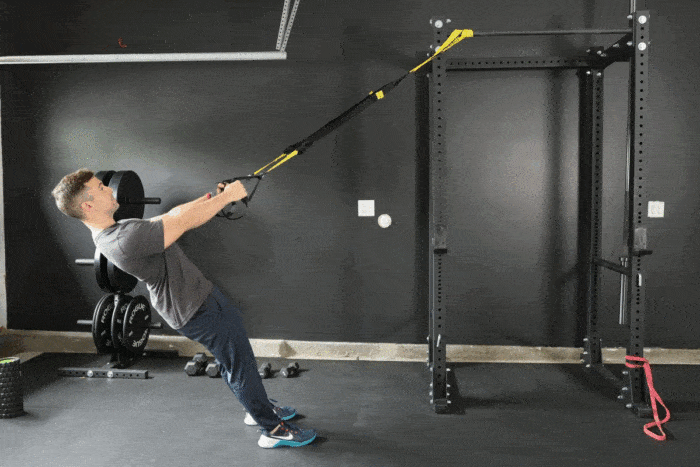
This traditional TRX Row has a few notable benefits worth highlighting:
- Beginner Friendly: Easy to modify the level of difficulty based on your level of fitness
- Increased Upper Body Strength: Helps improve overall upper body strength by targeting several muscle groups
- Improved Posture: Row exercises help strengthen the muscles responsible for your back posture when seated/standing.
2. TRX Low Row
The low-row variation is a modified version with increased difficulty.
A TRX Low Row exercise effectively targets the same muscles as its traditional counterpart.
However, you may notice an increased activation of the biceps and abs to help stabilize your body during this exercise variation.
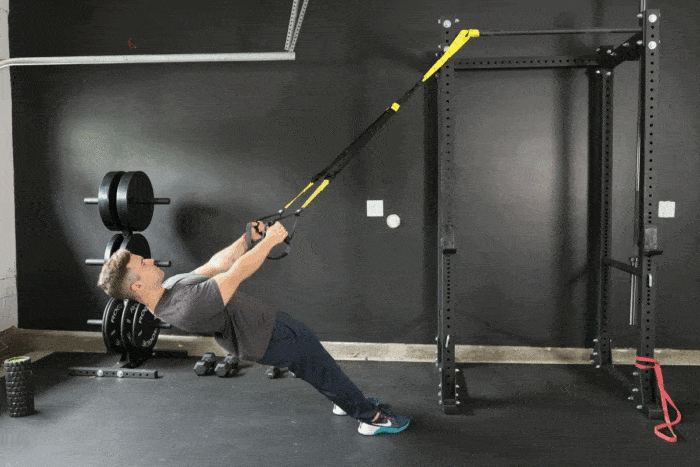
This TRX Low Row variation has a few notable benefits worth highlighting:
- Challenges Core Stability: This modified row variation increased the challenge by introducing core instability in the lower position challenging your core muscles.
- Increased Difficulty: By entering a lower body angle, you’re adding more tension across the target muscle groups by adding more bodyweight resistance.
3. TRX High (Rear Delt) Row
A TRX High Row is considered a moderately advanced exercise technique.
This row variation places most tension on the upper back muscles, including the rear deltoids, by shifting the elbows higher (and further away from the torso).
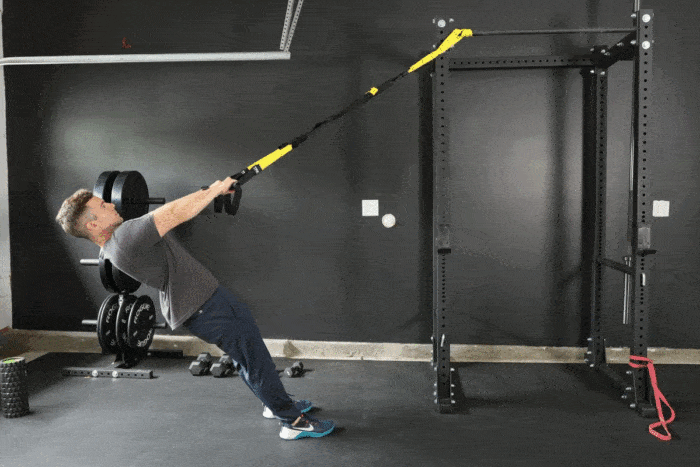
This TRX High Row variation has a few notable benefits worth highlighting:
- Beginner Friendly: Easy to modify the level of difficulty based on your level of fitness
- Improved Shoulder Strength: This exercise helps build strength by targeting the rear deltoids, traps, and upper rhomboids.
4. TRX Inverted Row
Inverted rows are a great transition exercise for beginners to develop enough strength to perform a pull-up.
The inverted row puts your body parallel to the floor, where you will experience the greatest resistance.
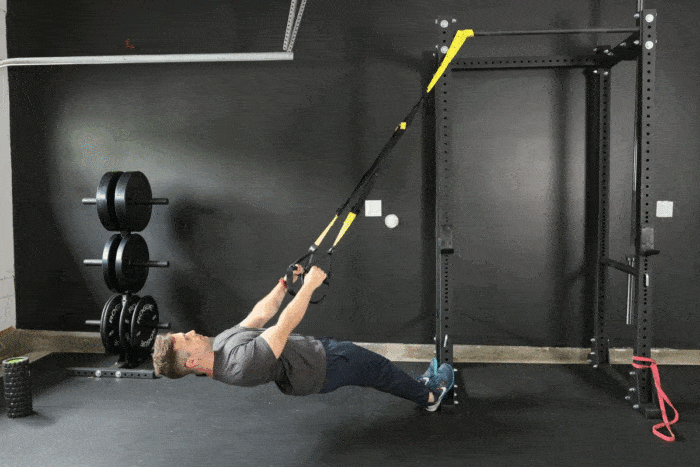
This TRX Inverted Row variation has a few notable benefits worth highlighting:
- Advanced Technique: This row variation offers a challenge for any fitness level through the inverted angle of your body and grip strength.
5. TRX Single-Arm Row
Unilateral exercises are critical to incorporate into any workout program.
Mainly, unilateral exercises like the single-arm row help limit muscular imbalances that can occur during bilateral movements (barbell bent over a row).
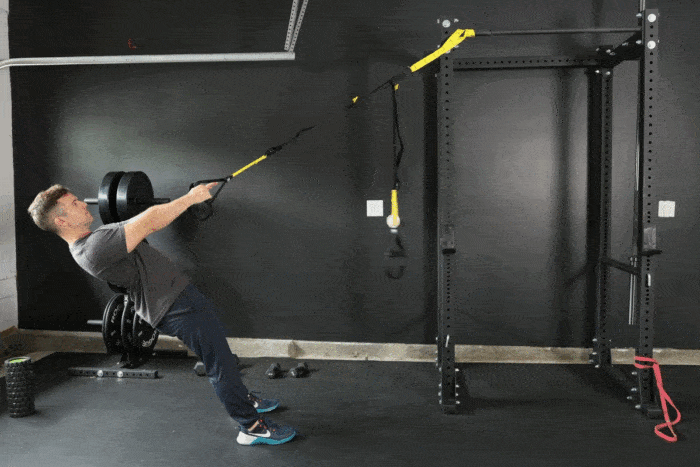
This TRX Single-Arm Row variation has a few notable benefits worth highlighting:
- Improved Muscle Activation: Increased firing rates of muscle motor units, which is important for developing strength
- Prevents Muscle Imbalances: Helps prevent overcompensation of dominant muscles on one side of the body
- Improved Muscle Mobility: Improves the ability of your stabilizing muscles to handle movement throughout different planes
If you want to understand how TRX exercises, like the inverted row, compare to traditional exercises in terms of muscle activation and intensity, check out this study on PubMed.
Frequently Asked Questions About TRX Rows
Here are some of the most common questions we’ve compiled and answered for you regarding this exercise.
What Muscles Does TRX Row Work?
TRX row is a back workout that strengthens your lats and engages your biceps. It’s great for improving your back muscles’ strength and posture.
How Do I Make My TRX Row Harder?
Adjust the difficulty of your TRX row by moving your feet closer or further away from the anchor point. The closer your feet are, the harder the exercise will be.
What Does TRX High Row Work?
TRX high rows target upper back muscles, traps, rhomboids, biceps and rear deltoids for a sculpted back.
What Is The TRX Low Row Good For?
It’s a powerhouse move for strengthening your mid-back muscles, like the lats and erector spinae. Plus, it’s great for improving overall posture and pulling strength – think of it as a secret weapon for a rock-solid back.
Are TRX Rows Effective?
TRX rows are great for building a strong back and improving functional strength. They engage multiple muscle groups, ensuring balanced development.
Does TRX Build Muscle?
TRX is a versatile tool that targets all muscle groups with bodyweight resistance, making it perfect for building a well-rounded physique.
Final Thoughts
Now you know the five most important rowing exercises for a strong and functional upper body. Incorporating pulling movements into your routine is essential for functional fitness and a stronger back.
TRX Suspension Training is a great way to incorporate functional movements into your workout.
Check out our guide if you need help setting up TRX at home.


